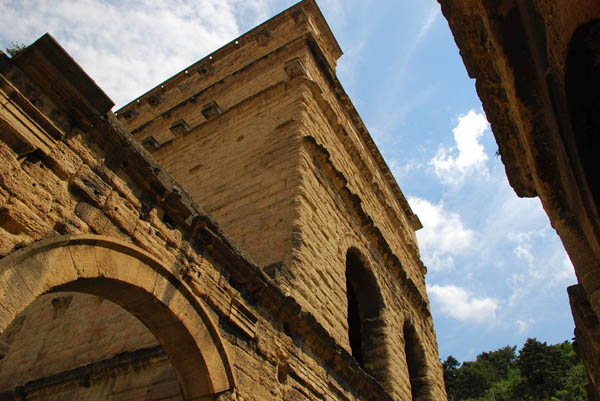

The ancient theatre and the archaeological site bordering it have been listed as historic monuments since 1840. The additions made – among others those that restored the theatre to its former use - respected the ancient substance. From the 19 th century onwards, clearing and restoration campaigns made it possible to consolidate these monuments. The triumphal arch was restored in 1824, one of the oldest interventions of this kind in France. The Roman monuments of Orange have come down to us as a result of several processes of appropriation that have adapted or transformed these buildings for other uses over the centuries.

This is generally the case with ancient vestiges, but the elements preserved are spectacular and sufficient to demonstrate the value of the property. The theatre, like these vestiges, and like the triumphal arch, are no longer in their original state. The property includes the entire Saint-Eutrope Hill which the theatre backs up against and where the known vestiges of the religious complex to which it belonged are located. Transformed into a fort in the 13 th century, partially repaired in the 18 th century, then restored in the 19 th century, the Triumphal Arch of Orange remains one of the most remarkable monuments of Roman Gaul.Ĭriterion (iii): From the Augustan Age, the ancient Theatre of Orange is an exceptional example in the typology of Roman theatres.Ĭriterion (vi): The events referred to in the low reliefs carved on the north face of the Triumphal Arch of Orange (war against the Barbarians and establishment of the Pax Romana) are of universal significance. Finally, on the upper attic, Roman and Celtic cavalrymen and infantrymen clash. In addition to this decoration, there are naval remains where prows, oars, anchors and aplustre, recall the control over the maritime world that the victory of Actium gave to Rome. On its north and south sides, Celtic weapons from the period of independence appear in fan shape on a wall on its east and west sides, the Celts are represented in chains. Built between 10 and 25 AD, the Roman Triumphal arch of Orange is one of the most beautiful and interesting provincial triumphal arches of the Augustan Age that has come down to us, thanks to its low reliefs commemorating the establishment of the Pax Romana. It was not until the 19 th century that the ancient theatre was reborn thanks to the restoration work begun in 1825. Closed by Imperial decree in 391, the theatre was abandoned and, later, ransacked and looted by Barbarians. Only a few vestiges remain of this original decoration, including the statue of Augustus displaced to the large central niche. Columns and numerous statues in niches originally decorated the stage. Built in the beginning of the Christian era, the ancient theatre presents all the components of the Latin Theatre according to Vitruvius: the cavea (semicircular tiers), the lateral accesses and the surprisingly preserved stage wall flanked by parascenia.

Situated in the Rhône Valley, in the Provence-Alpes-Côte-d'Azur region, the ancient theatre of Orange, with its 103 m long and 37 m high facade, is one of the best preserved of all the great Roman theatres.


 0 kommentar(er)
0 kommentar(er)
